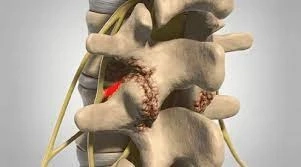Back pain is a common complaint from people of all ages, genders, and backgrounds. It can be caused by various issues, with one of the most prevalent being posterior disc osteophyte complex (PDOC). PDOC is a condition that involves degeneration in the spine, which can lead to back pain and other symptoms. It occurs when the discs of the spine begin to deteriorate, leading to enlargement of the joints and formation of bone spurs or osteophytes.
Overview of Anatomy
The posterior disc osteophyte complex is a type of degenerative spine condition that often affects the lower back region. It's a combination of degenerating discs and bony spurs that can cause pain and difficulty with movement. This condition is most commonly seen in older adults as it's associated with aging.
The anatomy of this complex involves several components including the intervertebral discs, vertebrae, ligaments, and joints. The intervertebral discs are located between each vertebrae providing cushioning and flexibility to the spine while the ligaments help maintain stability and range of motion in the spine. When these components break down due to age or injury, they can lead to the development of bone spurs which can compress nerves causing pain and other symptoms.
Causes
Posterior disc osteophyte complex is a condition caused by the degeneration of spinal discs in the lower back. The condition often causes pain and discomfort when the affected vertebrae press onto the nerves surrounding them, leading to a range of symptoms that may become progressively worse over time. It is most commonly seen in adults aged 40 or older, but it can affect people of any age.
The primary cause of posterior disc osteophyte complex is wear and tear on the spine due to aging and general activity, as well as injuries sustained during physical exertion or trauma. Poor posture over extended periods of time can also contribute to this underlying wear and tear on spinal discs, resulting in an increase in symptoms related to posterior disc osteophyte complex. In some cases, genetic predisposition may play a role in developing this condition as well.
Symptoms
Posterior disc osteophyte complex is a condition that can cause pain and discomfort in the lower back, hip, and leg. This condition occurs when there is an accumulation of bony growths, called osteophytes, at the posterior portion of a spinal disc. The pressure created by these growths can put direct pressure on the nerves in the spine leading to symptoms such as radiating leg pain and numbness or tingling. People suffering from posterior disc osteophyte complex may also experience reduced range of motion in their lower back accompanied by localized tenderness or stiffness.
The most common symptom associated with posterior disc osteophyte complex is sciatica.
Diagnosis
The diagnosis of posterior disc osteophyte complex is something that should be taken seriously by patients. At Premier Pain Management, we strive to provide the best care possible for each and every patient in order to ensure their overall well-being.
At Premier Pain Management, a diagnosis of posterior disc osteophyte complex requires a comprehensive evaluation in order to assess the current condition and any potential future complications. Our team of medical professionals will work with each individual patient in order to create an effective plan of action that will help manage pain and improve quality of life.
By using advanced imaging techniques such as MRI and CT scans, we are able to identify and diagnose the condition accurately so that we can initiate appropriate treatment as soon as possible.
Treatments may include lifestyle modifications such as physical therapy, medications, and even alternative medicine options if necessary.
Treatment
Posterior disc osteophyte complex is a condition characterized by the growth of bone spurs on the spine, which can cause pain and discomfort. Patients who suffer from this condition may benefit from treatment options offered by Dr. Ali, an experienced pain management specialist.
Dr. Ali has extensive experience in treating posterior disc osteophyte complex and offers a variety of treatments to reduce pain and improve quality of life. His approach focuses on non-surgical treatments such as physical therapy, medications, joint injections, and spinal manipulation to minimize stress on the spine while increasing flexibility and strength in the surrounding muscles. He also provides patient education to help them understand how to manage their symptoms at home between visits with him.
Prognosis
Posterior disc osteophyte complex is a condition that affects the spine and can cause back pain. It occurs when discs between two vertebrae become compressed, causing bone spurs to form. These bone spurs can press on nearby nerves, causing severe pain.
Treatment for a posterior disc osteophyte complex typically includes pain management techniques, physical therapy, and, in some cases, surgery. A variety of factors influence the prognosis for this condition, including the patient's age, health status, and the severity of symptoms.
When it comes to the prognosis of posterior disc osteophyte complex, early intervention is key in order to help reduce pain and prevent further damage or complications to the spine.
Prevention Measures
Posterior disc osteophyte complex is a condition in which small, bony outgrowths form on the vertebrae of the spine. These growths can cause pain, discomfort, and even other serious medical complications if left untreated. Fortunately, there are several preventative measures that individuals can take to ensure they avoid this painful condition.
First and foremost, it’s important to maintain healthy posture while sitting or standing for extended periods of time. This will help reduce strain on the spine and minimize chances of developing posterior disc osteophyte complex. Additionally, individuals should always use correct lifting techniques when picking up heavy objects and engage in regular exercise to strengthen muscles that support the back. Exercise can also help improve flexibility and range of motion in the spine which is beneficial for preventing this condition from occurring over time.
Conclusion
The posterior disc osteophyte complex can cause a number of issues for patients, including pain and decreased range of motion. This condition is one of the most common causes of lower back pain in adults, and it can be extremely difficult to treat. In order to alleviate symptoms and achieve long-term relief, it is important for individuals to understand the causes and available treatment options before making any decisions about care.
The presence of a posterior disc osteophyte complex typically requires an MRI examination in order to accurately diagnose. After diagnosis, treatment could include physical therapy, medications such as anti-inflammatory drugs or steroids, or even surgery if necessary. It is important to note that while these treatments may provide temporary relief from symptoms, they do not cure the condition itself.


